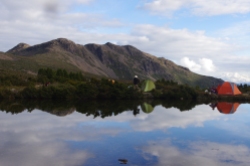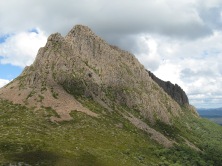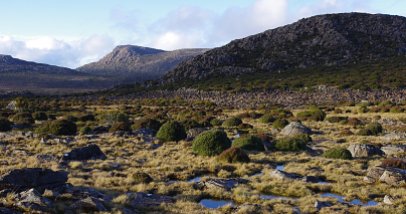SOME MILESTONES IN THE EVOLUTION OF THE ALPS/SOUTH EAST FORESTS WORLD HERITAGE NOMINATION PROPOSAL
1969 – About this time Dewar Goode began to argue for international heritage protection for Australian Alps.
1977 – Submission by Australian Academy of Science to Land Conservation Council (LCC) on Alpine Area Study argued that Victorian Alps needed serious consideration as World Heritage.
1981 – Alec Costin in article on Victorian and NSW Alps in ‘The Heritage of Australia’ wrote – “ a continuous Alps National Park could qualify as World Heritage”.
1987, May/July – Studies carried out on world heritage values of South East Australia, including Roger Lembit’s ‘World Heritage Values of Eucalypt Forests in Southern New South Wales, July, 1987’.
1987, September – Margaret Blaker’s compilation of studies of South East Australia published as ‘Australia’s Eucalypt Forests World Heritage Values A Preliminary Study of Eucalypt Forests in South Eastern Australia’. It identified sites that may qualify for World Heritage listing. Made special reference to Rodger River, Errinundra and Tantawangalo.
1987, November – Premier John Cain announced Government’s intention of seeking World Heritage listing for the national parks of East Gippsland and the Alps.
1987, December – ACF added Alps and East Gippsland Parks covering 1.6 million hectares to its list of areas which it believed should be nominated for World Heritage List.
1988, September – Victorian National Parks Association (VNPA) published ‘Australian Alps World Heritage Nomination’ book prepared by Geoff Mosley. It stressed the advantages of a nomination covering the forests and the Alps for continuing speciation. Endorsed by Victorian Government at launch by Joan Kirner.
1988, September – First Fenner Conference on the Environment on the subject of ‘The Scientific Significance of the Australian Alps’ passed a resolution in favour of World Heritage listing.
1989, July – Prime Minister Bob Hawke in his ‘Statement on the Environment Our Country Our Future’ promised that the Australian Alps would be investigated against strict World Heritage criteria. This led to a number of reports on natural values (Boden on ACT, 1991; Good on Kosciusko, 1992; Busby on Eastern Victoria, 1992 and Kirkpatrick (overview), 1994 ) and to Lennon’s 1999 report on cultural values. All were supervised by Australian Alps Liaison Committee and there were problems (involving representations by ACF) with geographic coverage with NSW forests excluded. Kirkpatrick was not allowed to include forests of NSW and had to cover East Gippsland forests in an Appendix.
1990, December – In his published comments on Busby’s draft report Alec Costin (included in the report) Alec Costin wrote “This alpine to coast range of environments presents a rich spectrum of interrelated sclerophyll (mainly eucalypt dominated) ecosystems ‘which is virtually unparalleled in the world and is thus of very high international significance’’.
1991, December – ACF expanded its proposed World Heritage area to include specified parks and reserves in East Gippsland and South Eastern NSW.
1991 – VNPPA and ACF began a national effort to promote the case for the Alps/Forests World Heritage nomination. It was stepped up in 1994 after the release of the Kirkpatrick report,( see below) with articles published in magazines, newspapers, etc.
1991-92 – Alps and East Gippsland submitted to Federal Minister for inclusion
on Australia’s Indicative List of World Heritage sites by ACF and Victorian Government (ACF submitted NSW forests in early 1995).
1992 – Earth Foundation published Mosley and Costin’s report ’World Heritage Values and Their Protection in Far South East New South Wales’. It attested to the World Heritage values there, explained what would be added to the nomination if these areas were included and suggested a change of name to reflect the inclusion of the forests.
1992 – Geoff Mosley presented arguments for World Heritage Listing in ‘The Geographie Alpine Tome LXXX (2-3)’.
1994 – Jamie Kirkpatrick’s report of 1993, – ‘The International Significance of the Natural Values of the Australian Alps’,- concluded that “The arguments in the nomination would be greatly improved by the inclusion of Mt Buffalo National Park, the Errinundra National Park, the Coopracambra National Park and the Croajingolong National Park. However, the non-inclusion of the parks in South eastern New South Wales reduces the potential strength of the East Gippsland inclusions’. [This was a reference to the fact that the south east of NSW was outside his brief]. And “ of course the case would be strengthened even further if the Croajingolong Park could be linked to the Snowy River National Park through Coopracambra and Errinundra”.
1996 – By this stage 25 NGOs (7 national) were involved in the campaign initiated by the VNPA in support of the Alps/South East Forests nomination. However, in 1996 the Comprehensive Regional Assessments (CRAs) were commenced as part of the preparation for Regional Forest Agreements and the effort was switched to the CRAs which involved study of World Heritage values including reports from a World Heritage Expert Panel which carried out the first two steps ( A – identify Australian themes and B – identify which areas matched those theme) of a five step process.
1996, July ‘East Gippsland – Environment and Heritage Report published containing record of meeting of World Heritage Expert Panel meeting of 13-14 June on Victoria. The Panel concluded that the Eastern Forests warranted further investigation beyond the first two steps saying “A strong nomination focussed on Eucalyptus evolution and diversity would include a wide variety of environments. An excellent representative sample of these can be found in south east Australia centred on East Gippsland, encompassing a range of habitats from the sea to the alpine herb fields and then to the inland plains”.
1997, 3rd February – East Gippsland RFA signed (ACF had urged deferment until after further steps of assessment carried out). Parties agreed to actively investigate and participate in World Heritage assessment of the Australia-wide Eucalypt theme including any potential contribution from East Gippsland. The RFA stated that “any potential nomination for World Heritage involving areas in East Gippsland could be achieved within the CAR Reserve System”. CAR reserve system referred to the JANIS criteria of ‘comprehensive, adequate and representative’ developed in pursuance of the 1990 National Forest Policy.
1997, 5th February – Federal Environment Minister, Robert Hill, advised Senate that under obligations to World Heritage Convention Australia could consider areas outside the CAR reserves (relevant to the future linkage of the dedicated reserves in the RFA).
1997, January – South East Forests National Park of 150,000 hectares created incorporating a number of national parks and nature reserves in an extended NSW national park.
1998, January – ‘World Heritage Report Record of the World Heritage Expert Panel Meeting Western Australia, New South Wales and Queensland’. Similar finding to East Gippsland re a cross-section of natural eucalypt forests describing it as applying to “parts of south eastern New South Wales, eastern Victoria and the Australian Capital Territory” and “extending from the sea to the alps and inland slopes”.
1998 – Australia nominated Greater Blue Mountains Area (GBMA) for World Heritage List. As IUCN (advisor on natural properties to World Heritage Committee) opposed the nomination on grounds that it did not represent the full range of eucalypt diversity Alps/Forests campaign was suspended ( to deny IUCN local ammunition against Blue Mountains).
1999 – Victorian ALP made election promise re support for World Heritage listing of Alps and Wilsons Promontory National Park.
1999, May – Jane Lennon’s report on ‘The International Conservation Significance of the Cultural Values of the Australian Alps’ published (limited to alpine region).
1999 – World Heritage Bureau recommended deferment of GBMA World Heritage nomination and invited Australia to consider an Australia-wide serial nomination (ie the IUCN position).
1999, August – Eden RFA contained similar references to World Heritage to those in East Gippsland RFA.
2000, January – Supplementary documentation provided by Australia on GBMA. Strongly contended that GBMA met the World Heritage criteria “in its own right”.
2000, March – Gippsland RFA made references to World Heritage similar to East Gippsland RFA ie “ areas with outstanding examples of Eucalyptus-dominated vegetation associated with the Eastern Forests of Victoria.
2000, September – ACF wrote to Prime Minister and Governments of NSW, Victoria and ACT in favour of a stand alone World Heritage nomination similar to that of GBMA.
2000, November – although IUCN still sought deferral on grounds that question of a serial site had not been addressed and areas not identified (IUCN referred to possible areas in South West Australia, Alps and East Gippsland). GBMA was inscribed on World Heritage List for evolutionary significance and biodiversity of its natural vegetation.
2002, July – report by Geoff Mosley to Victorian Government recommended inclusion of Wilsons Promontory National Park in Alps/South East Forests nomination.
2002, August – ACF wrote again to all Governments repeating its support for separate Alps/Forests World Heritage nomination.
2004, March – ACF again wrote to all relevant Governments urging support for Alps/South East Forests nomination.
2005, February – John Blay published ‘Bega Valley Old Path Ways and Trails Mapping Project’. Referred to pathways in South East NSW and between this area and Alps.
2005, May – Victorian Government announced decision not to renew grazing licences in Alpine National Park after August, 2005, removing a potential obstacle to World Heritage nomination. However, at Kosciuszko National Park NSW Government continued to pursue major expansion of resorts in Park.
2005, July – Colong Foundation formed representative working group to further develop and promote the Alps/South East Forests World Heritage nomination.
2005, July – Federal Environment Minister, Ian Campbell, declared in favour of a Greater Alpine National Park and stated that a National Heritage listing for the Park could be a step to a World Heritage nomination.
2005, October – Federal Environment Minister released proposal for Greater Alpine National Park (based on proposal by National Park Associations of Vict, NSW and ACT) with grazing and Australian Heritage Trust to fund initiatives. Then decided not to proceed immediately, leaving the proposal on the table.
2005, October – Nature Conservation Council of New South Wales passed resolution – “That the Nature Conservation Council of New South Wales strongly supports the ‘sea to snow’ concept underlying the proposed Alps and Forests of South East Australia World Heritage nomination”.
2005, December – The South East Region Conservation Alliance voted to support the campaign.
2005, December – NSW Minister for the Environment, Bob Debus advised Colong Foundation of NSW Government’s consideration of support for World Heritage listing on the ‘sea to snow’ concept “once national heritage listings have been successful”.
2006, September – NSW Environment Minister, Bob Debus advised intention to develop an MOU for the cooperative management of the Vict/NSW border forest parks subject to agreement by Parks Victoria.
2006 Victorian State Election – ALP renews its support for the World Heritage nomination and promises to extend the Alpine National Park to incorporate Snowy River and Errinundra National Parks and other areas between these parks and adjacent to Errinundra (legislation now proposed for “within current term of office”). NB Earlier the Alps and South East Forests Working Group had published a proposal involving the amalgamation of the parks and reserves of East Gippsland into an East Gippsland Forests Park matching the South East Forests National Park across the border in NSW. In late 2009 action on this commitment was imminent.
2006/2007 – National Heritage List nominations submitted for the various constituent parts of the proposed ‘sea to snow’ World Heritage nomination including: Kosciuszko National Park; Alpine Park; Greater Croajingolong Area; Greater Errinundra Area, Greater Coopracambra Area; South East Forests NP/Egan Peaks Nature Reserve; Nadgee Nature Reserve; Bournda National Park and Nature Reserve, Western Alps’ Link and Sea to Alps Aboriginal Pathways. NB these nominations, if adopted, would create continuous national heritage corridors from the sea at the Bourndas and Croajingolong/Nadgee to the Alps as a basis for a World Heritage nomination (policy of Howard and Rudd governments is to confine World Heritage nominations to areas on the National Heritage List).
2007, March – in an election statement before winning the 2007 election the NSW ALP committed to working with the Victorian and ACT Governments for an Alps World Heritage nomination.
2007, November – Rudd led ALP Government elected and in 2008 commences process of extending Australia’s Tentative World Heritage List.
2008, January – Proposal for an extension of the Alpine National Park westwards to and including the Baw Baw National Park developed and submitted. Proposal is endorsed by World Commission on Protected Areas in letters to Victorian Minister/Shadow Minister and in letters to the ACT, NSW and federal Ministers suggesting they endorse it through the forum of the Alpine Ministers’ Council.
2008, November – Addition of 11 protected areas in Alps (national parks, nature reserves and a wilderness reserve) covering 1.6 million hectares to National Heritage List.
2009, October – By this date both Victoria and ACT had submitted their parts of the proposed ‘sea to snow’ nomination for Australia’s Tentative World Heritage List but NSW had not. The Victorian proposal includes the Alpine, Baw Baw Mt Buffalo, Snowy River, Coopracambra, Croajingolong and Errinundra National Parks, Avon Wilderness Park and Cape Conran CP.
2009, October 31st- – Nature Conservation Council of NSW unanimously passed urgency resolution calling on New South Wales to join with Victoria and ACT in supporting the addition of the Alps and South East Forests to Australia’s Tentative World Heritage List.
2009, November – ACF Council at its 117th meeting also passed a resolution urging New South Wales to agree to having the Alps and South East Forests added to Australia’s Tentative World Heritage List (letter sent by ACF to NSW Premier with copies to Premier of Victoria, NSW Chief Minister and federal Environment Minister on 22nd June, 2010).
2009, December – Passage of Crown Land Amendment (East Gippsland) Bill 2009 added 45,000 hectares to the parks and reserve system in East Gippsland including establishment of a link between the Snowy River and Errinundra NPs.























































Leave a comment